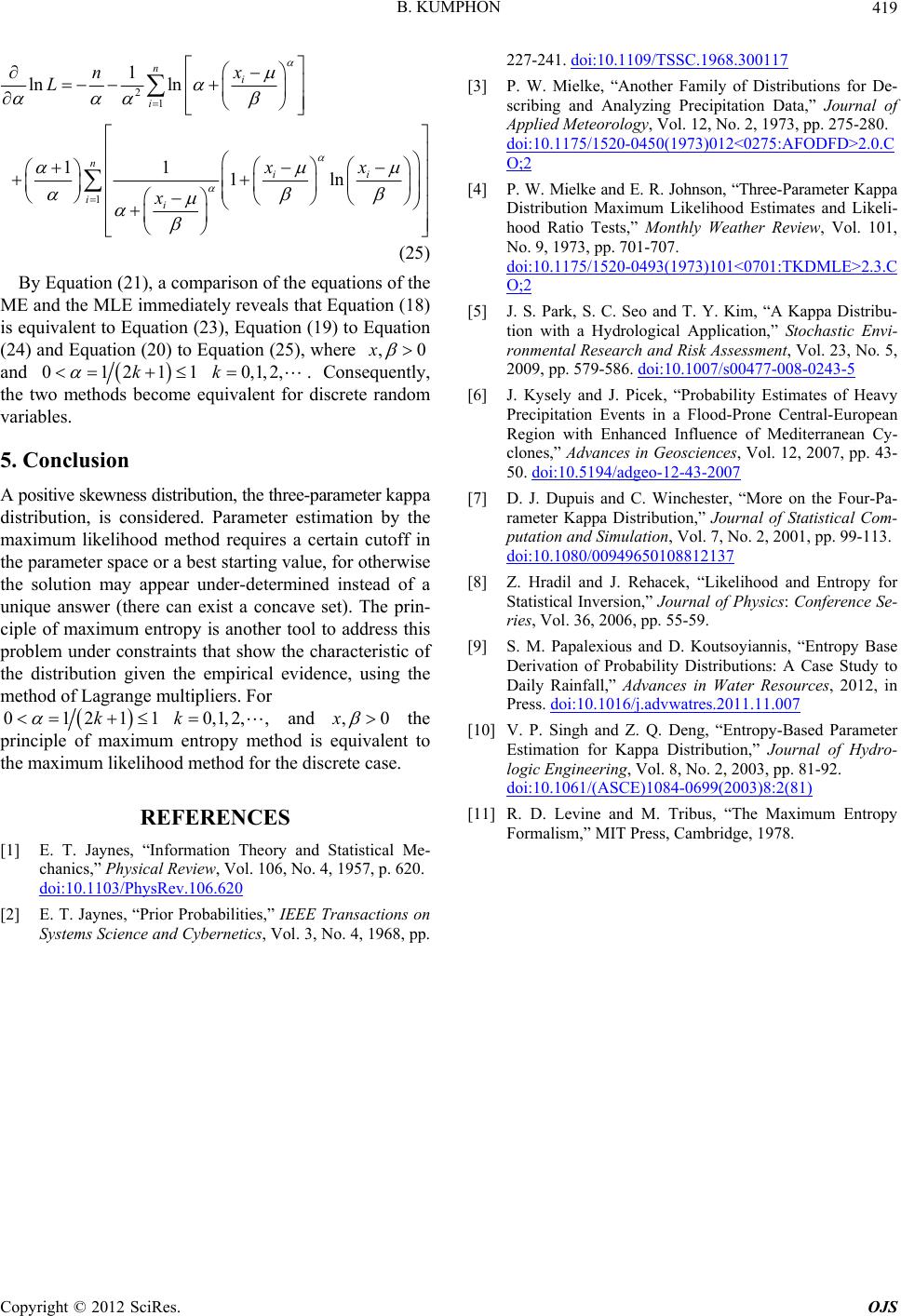
B. KUMPHON 419
21
1
1
ln ln
11
1l
ni
i
n
ii
x
n
L
x
n
ii
xx
,0x
(25)
By Equation (21), a comparison of the equations of the
ME and the MLE immediately reveals that Equation (18)
is equivalent to Equation (23), Equation (19) to Equation
(24) and Equation (20) to Equation (25), where
and
01211kk
0,1,2,. Consequently,
the two methods become equivalent for discrete random
variables.
5. Conclusion
A positive skewness distribution, the three-parameter ka p pa
distribution, is considered. Parameter estimation by the
maximum likelihood method requires a certain cutoff in
the parameter space or a best starting value, for otherwise
the solution may appear under-determined instead of a
unique answer (there can exist a concave set). The prin-
ciple of maximum entropy is another tool to address this
problem under constraints that show the characteristic of
the distribution given the empirical evidence, using the
method of Lagrange multipliers. For
01211kk
,0x0,1,2,, and
the
principle of maximum entropy method is equivalent to
the maximum likelihood method for the discrete case.
REFERENCES
[1] E. T. Jaynes, “Information Theory and Statistical Me-
chanics,” Physical Review, Vol. 106, No. 4, 1957, p. 620.
doi:10.1103/PhysRev.106.620
[2] E. T. Jaynes, “Prior Probabilities,” IEEE Transactions on
Systems Science and Cybernetics, Vol. 3, No. 4, 1968, pp.
227-241. doi:10.1109/TSSC.1968.300117
[3] P. W. Mielke, “Another Family of Distributions for De-
scribing and Analyzing Precipitation Data,” Journal of
Applied Meteorology, Vol. 12, No. 2, 1973, pp. 275-280.
doi:10.1175/1520-0450(1973)012<0275:AFODFD>2.0.C
O;2
[4] P. W. Mielke and E. R. Johnson, “Three-Parameter Kap pa
Distribution Maximum Likelihood Estimates and Likeli-
hood Ratio Tests,” Monthly Weather Review, Vol. 101,
No. 9, 1973, pp. 701-707.
doi:10.1175/1520-0493(1973)101<0701:TKDMLE>2.3.C
O;2
[5] J. S. Park, S. C. Seo and T. Y. Kim, “A Kappa Distribu-
tion with a Hydrological Application,” Stochastic Envi-
ronmental Research and Risk Assessment, Vol. 23, No. 5,
2009, pp. 579-586. doi:10.1007/s00477-008-0243-5
[6] J. Kysely and J. Picek, “Probability Estimates of Heavy
Precipitation Events in a Flood-Prone Central-European
Region with Enhanced Influence of Mediterranean Cy-
clones,” Advances in Geosciences, Vol. 12, 2007, pp. 43-
50. doi:10.5194/adgeo-12-43-2007
[7] D. J. Dupuis and C. Winchester, “More on the Four-Pa-
rameter Kappa Distribution,” Journal of Statistical Com-
putation and Simulation, Vol. 7, No. 2, 2001, pp. 99-113.
doi:10.1080/00949650108812137
[8] Z. Hradil and J. Rehacek, “Likelihood and Entropy for
Statistical Inversion,” Journal of Physics: Conference Se-
ries, Vol. 36, 2006, pp. 55-59.
[9] S. M. Papalexious and D. Koutsoyiannis, “Entropy Base
Derivation of Probability Distributions: A Case Study to
Daily Rainfall,” Advances in Water Resources, 2012, in
Press. doi:10.1016/j.advwatres.2011.11.007
[10] V. P. Singh and Z. Q. Deng, “Entropy-Based Parameter
Estimation for Kappa Distribution,” Journal of Hydro-
logic Engineering, Vol. 8, No. 2, 2003, pp. 81-92.
doi:10.1061/(ASCE)1084-0699(2003)8:2(81)
[11] R. D. Levine and M. Tribus, “The Maximum Entropy
Formalism,” MIT Press, Cambridge, 1978.
Copyright © 2012 SciRes. OJS